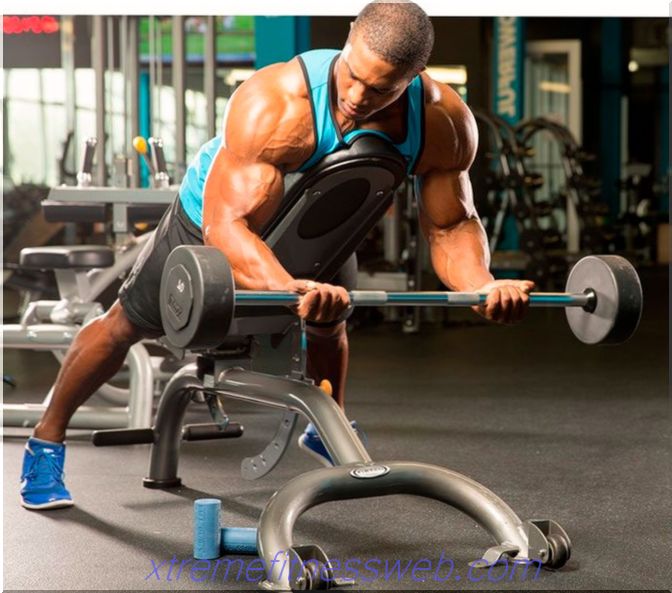- Working muscles
- Weight selection and warm-up exercises
- Execution technique
- Contraindications
- Training Recommendations

The deltoid muscles are composed of the anterior, middle and posterior bundles. They participate in all bench presses. Raising your arms forward, pushing yourself and up is their main function. The front deltoid bundle works when we open the door, put our hand out in front of us, or try to shake the barbell in the hall. This muscle is not large, but its development is important not only for aesthetics, but also as a prophylaxis for injuries. Climbing in front of you is a great insulating exercise for the front delta.
Content
- 1 working muscles
- 2 Weight selection and warm-up exercises
- 3 Technique
- 4 Contraindications
- 5 Training Recommendations
Working muscles

The main mover in lifting dumbbells or bar in front of you is the front bundle of the deltoid muscle of the shoulder. Stabilization of the movement occurs due to the inclusion of the middle deltoid beam. If the athlete spreads the dumbbells while moving slightly to the sides, an additional inclusion of the rear delta is possible. But such a technique in fitness is not desirable, as it transfers the load from the target muscle.
As stabilizers, quadriceps, thigh biceps, buttocks, abs, calf muscles are involved. Heavy dumbbells are quite difficult to lift while holding the body upright. Therefore, the athlete should fix the starting position due to the static tension of the listed muscles.
Important: training the arms and shoulders cannot consist solely of swings. For harmonious development, you need to perform dumbbell presses up, train chest, triceps, and back. This movement is performed as an isolating one of the exercises of the training plan.
Weight selection and warm-up exercises

This movement is recommended for beginners to start with 2-5 kg. At the same time, a couple of kilos is advised to girls, and 5 to men. In fact, the weight chosen is not so. You need to take the lightest dumbbells that are available and perform the exercise approach, with your back pressed to any support. If you manage to do 10-12 repetitions without any problems, and you have the strength to continue, it is worth adding another kilogram. So they move until they come to weight, the rise of which by 10-12 repetitions will be sufficient to experience a burning sensation in the front deltas
Warm-up approaches are taken 4-5 kg less than the main, then the weight gradually increases. It must be borne in mind that the exercise is performed at the end of the bench press while standing or lying down, so the athlete is already warmed up. But this is not a reason to skip the warm-up approach, since only it guarantees the safety of the main work, and allows you to completely avoid injury.
Important: general warm-up and joint warm-up should precede any chest or shoulder workout. Often, athletes neglect this, because they think that shoulders are easier to swing than legs, and therefore you can warm up during work. Rotations in the shoulder joints and rehabilitation exercises are best not to be missed, otherwise the training may result in injury.
Execution technique

The most important thing is to take a starting position in which the case will be stable, and swinging can be avoided. In normal fitness, it is not recommended to do this movement with cheating, as throwing weight above the shoulder line can lead to injuries.
You should stand up straight, reduce abdominal muscles, slightly bring the lower ribs to the pelvis, firmly rest your feet on the floor, and strain the quadriceps and buttocks. Dumbbells are taken either with a direct grip or with a “palm up” grip. The movement is as follows:
- Weight lifting due to the effort of the front deltas at shoulder level;
- Lowering on the exhale without "losing" weight;
- Dumbbells along the entire trajectory are at the same distance from each other. It is not necessary to “carry” them too much around so that the middle deltas are included in the work;
- Lifting with the rotation of the dumbbells around the axis of the neck is allowed only for a variety of training and with light weight;
- Beginners can lift dumbbells one at a time, if there is no stability and it is impossible to not include legs when lifting weights;
- If it doesn’t come out to keep the trajectory relatively equal to the right and left, it’s worth performing a similar exercise - standing upright
The pace of execution should not be high, it is enough to work out on average, only 11-15 repetitions. This exercise is not suitable for a strength test, moderate weights and pace are needed.
Contraindications

It is believed that there are only two of them:
- Abdominal surgery (rehabilitation takes six months);
- Shoulder injuries
In fact, there are more of them. No need to perform swings and rises with spasms of the trapezius muscle, exacerbation of pain with osteochondrosis or arthrosis. It makes sense to abandon auxiliary exercises, and if the athlete is having problems recovering from heavy bench presses.
This movement does not need to be included in the plan “instead of” the dumbbell presses and barbell on the shoulders, if the goal is to completely unload the joint. In case of problems with recovery, it makes sense for the athlete to choose complete rest for several days, or bench presses with light rubber, but not swinging weights.
Training Recommendations

No need to wave dumbbells as it happens. It is worth following a few simple rules to get the best result:
- Bringing dumbbells forward is allowed only due to the strength of the target muscle group. Do not perform lifting due to the "dumping" of weight and the subsequent inertial movement forward;
- Lifting dumbbells does not need to be done through the sides in an arc, work is strictly forward;
- The position and position of the spine should be monitored. The back is straight, the shoulders are not raised to the ears;
- Head nods, neck tilts forward, swings head back during exercise are not allowed. The cervical spine remains neutral, despite the load;
- No need to take dumbbells upstairs, as many do;
- Rotation in the hip and knee joint, “throwing” of weight forward and swinging is not allowed;
- You need to lower it smoothly, without resetting;
- Beginners should lift the dumbbells in a neutral position, not use the technique when the little finger is displayed above the thumb
Exercise should be performed in the usual controlled manner. Sometimes women are advised to do it to reduce body fat on the arms and shoulders. But this is not entirely true. Fat burning completely depends on whether a calorie deficiency has been created. If this goal is not achieved, the exercise will not help. Therefore, losing weight is often advised to increase domestic activity, or to do cardio after a workout to increase energy consumption.
Lifting dumbbells forward should be done at the end of the bench press training, or after shoulder exercises. This is a muscle-isolating movement, so the weights should be moderate, the technique should be completely controlled, and the volume should not exceed 3-4 working approaches. Periodically, you can vary your workout by performing a barbell movement instead of this lift.







